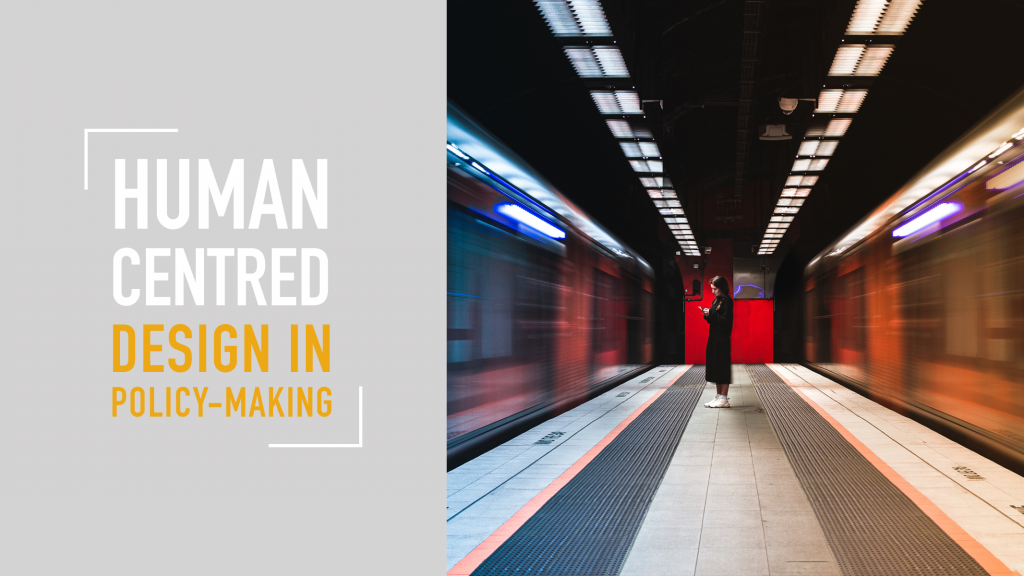In one of our last blogs we argued that the political organisation of the future will provide citizens and stakeholders with opportunities to develop their offers (e.g. policies) in close collaboration with them.
From the many reactions we received on this blog, one question kept us thinking: “There are already initiatives to make citizens part of the policy-making process, e.g. France, Finland, Taiwan. But is there a systematic approach or process out there?”
To answer this question, we start this blog series. In this first blog we will provide you with insights into human-centred design in policy-making. In the next blog we will then outline a coherent process on how to systematically integrate citizens in policy-making and -delivery.
Design Thinking in the public sector
Design Thinking is an innovation method that spread around the globe in the last two decades. It is an interactive process to develop a new product or service. The focus is on the actual needs of the users, looking at a given problem from their angle and going through several feedback loops to fulfill that need. In that way it differs from traditional product development, as the user comes in at every stage of the process, and not just at the end.
In the private sector, the concept of Design Thinking is well established. From Starbucks, Airbnb to Toyota – many companies use Design Thinking in their R&D efforts. But, over the last decade Design Thinking has become more popular in the public sector as well: a variety of Innovation Labs have been founded in the last years to apply the principles of Design Thinking in the public sector to create citizen-centered solutions. Examples are COI in Denmark, which supports public institutions in their innovation endeavours and GDS in the United Kingdom, which design online solutions with and for public administrations.
Especially in delivering services to citizens, Design Thinking has proven to be a useful tool. The redesign of the application process for grants at the Department of Industry, Innovation and Science in Australia or the organization and operation of public hospitals in Denmark are just two examples.
Why human-centred design fits the public sector
The human-centered and iterative approach seems to be a good fit for the needs of the public sector:
- Increasing acceptance: By incorporating the needs and ideas of citizens in the development of new products services to public problems, citizens are more likely to accept changes as the new offer reflects their reality.
- Increasing efficiency: Design Thinking can lead to a more efficient use of resources like time or money. Although the development process may take longer in the beginning, through testing and feedback, problems are avoided in the long run.
- Increasing adaptiveness: A central criticism of democracy today is that it cannot keep up with the pace of a rapidly changing world. By applying Design Thinking political organisations stay adaptable to the needs of citizens and therefore embrace change as part of the process.
Human-centered design in policy-making
When it comes to policy-design however, the application of Design Thinking becomes a bit tricky. The procedural and legal context of policy development, as well as the expectation of citizens to act with budgetary rigour, make it harder to apply experimentation and learning. The benefits outlined above still hold true for policy-design, but it takes more creativity to harvest them in reality.
In our research, one example stood out which proved that human-centred design in policy-making can be successfully applied: In 2015, the US Congress developed a new bill for the payment of physicians across the US. After the bill passed Congress, a team of experts was asked to implement and feedback this new policy. The team chose a human-centred design approach and incorporated an inward (needs of the administration) and outward (needs of the physicians) perspective into the needfinding and testing phase of the policy-development process.
Through this process, the experts discovered that some policies within the new bill were not applicable in reality. By feedbacking these insights, Congress was able to re-shape the policy in line with the reality of physicians.
A coherent approach towards human-centred policy delivery
In our next blog, we will introduce you to a new framework we developed: a coherent process that integrates the principles of Design Thinking into policy-making and delivery.
To provide you with a spoiler: it is a seven-stage-process which holds several opportunities for civic participation.
Have you ever let citizens participate in policy-making? What are your experiences? Any insights you want to share? Looking forward to hearing your thoughts!
